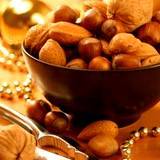|
Grandma's Copper Mineral GuideIt also is involved in the healing process, energy production, hair and skin coloring, and taste sensitivity. This mineral is also need for healthy nerves and joints. One of the early signs of copper deficiency is osteoporosis. Copper is essential for the formation of collagen, one of the fundamental proteins making up bones, skin, and connective tissue. Other possible sign of Copper deficiency include:
A lack of copper can also lead to increase blood fat levels. Excessive intake of Copper can lead toxicity, which has been associated with:
Natural Food Sources of Copper
Comments: The level of Copper in the body is related to the levels of Zinc and Vitamin C. Copper levels are reduced if large amounts of Zinc drop. The consumption of high amounts of fructose can significantly worsen a copper deficiency. In a study conducted by the U.S. Department of Agriculture, people who obtained 20 percent of their daily calories from fructose showed decreased levels of red blood cell superoxide disismutase (SOD), a copper-dependent enzyme critical to antioxidant protection within the red blood cells.
|








